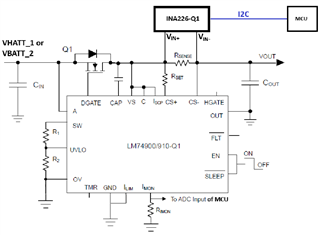Other Parts Discussed in Thread: INA226-Q1
Tool/software:
Hi,
In our automotive project, we have two battery supplies with an upper bound on each for the max. continous current consumption (mostly inposed by the input filter, inductor DC current is max. 115A).
Since some high-side switches / eFUSE / bridges are connected directly to one of the input battery (VBATT_1 or VBATT_2) while others to the output of the active ORing (VBATT_OR) made by two LM74910-Q1 to provide redundant power supply, we need to know exactly in real-time:
1.) which battery supply has higher voltage (VBATT_1 or VBATT_2) in order to know that the loads connected to the output of active ORing consume current from which battery input,
2.) actual current of VBATT_1 and VBATT_2 (wo. the current consumed by VBATT_OR), respective actual current of VBATT_OR so the continous max. 115A limit per battery input is not violated.
That requires for the MCU to have a more precise current measurement, respective to measure the input battery supply with precision. The LM74910-Q1 has only analog input proportional with load current w. only 10% precision, but no voltage measurement. For this reason we were thinking to use INA226-Q1 that support sleep mode.
However, we also need to provide reverse battery protection for bridges, respective negative pulse protection for eFUSE/HSS devices (and since max. -16V is allowed for HSS, TVS diode is out of question), we would like to use additional two LM74910-Q1 devices for ideal diode controller with sleep mode for each battery input.
My question is, that in order to minimize the power dissipation on shunt resistors, can we use the same sense resistor (e.g. shunt resistor is shared between LM74910-Q1 and INA226-Q) without affecting the functionality of both devices?
Does in any way affect the precision of INA226-Q1? My answer would be NO, but I would like to double check with you.

The same would apply for the active ORing, INA226-Q1 device would be attached to the sense resistor.
Regards,
Ferenc


